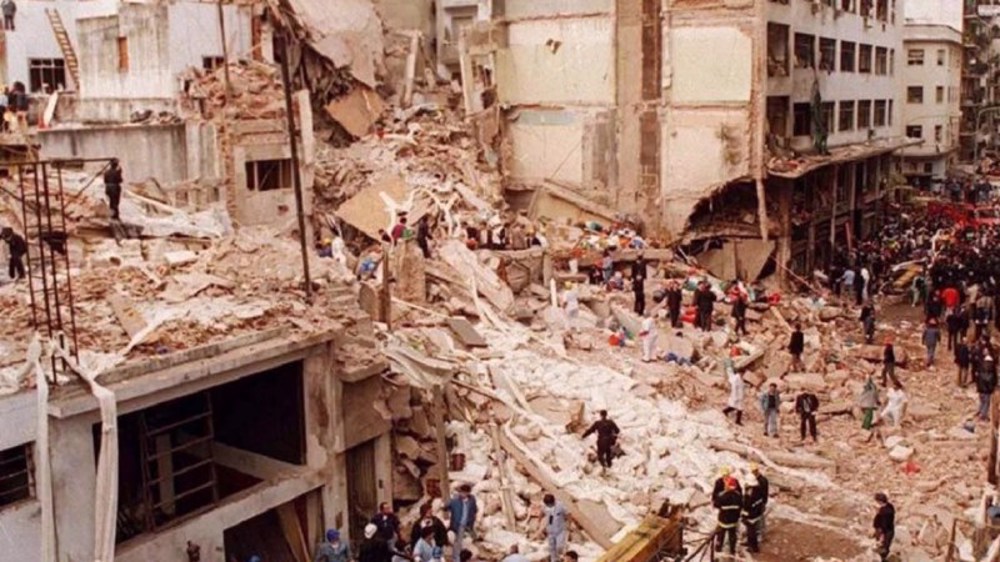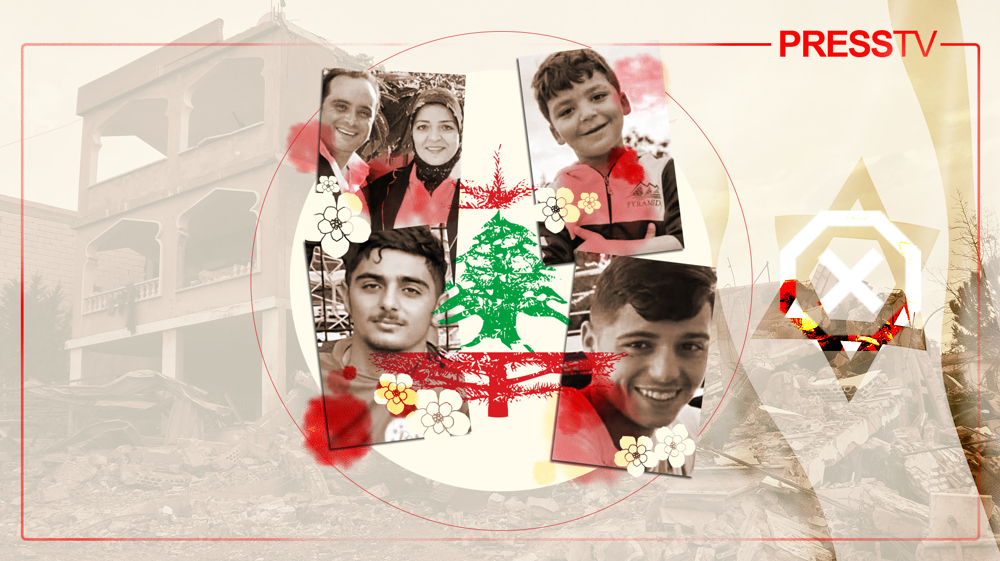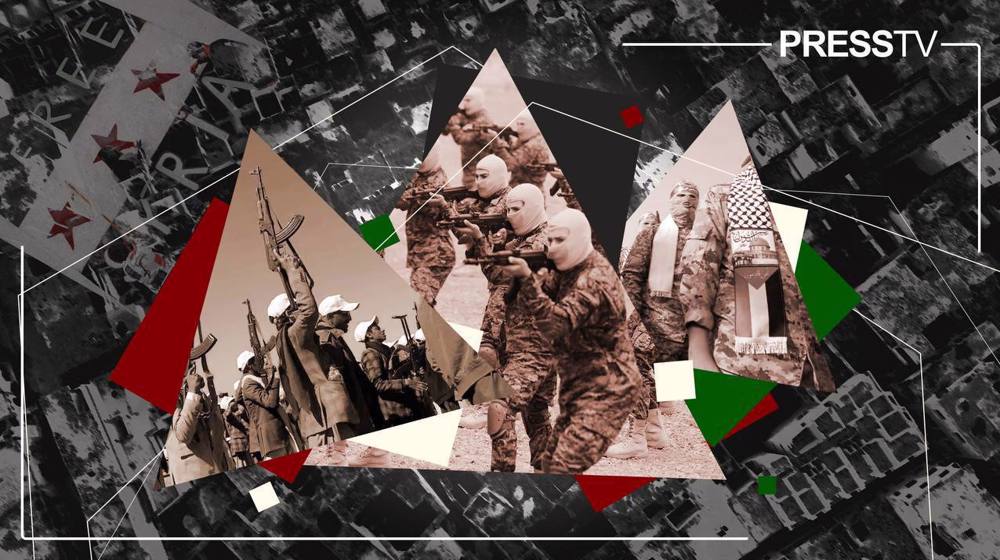How police spy’s stunning testimony threatens official US-Israeli AMIA bombing narrative
By Gareth Porter
Revelations by a former police spy upend the official story blaming Iran for the 1994 bombing of a Jewish community center in Buenos Aires, and suggest a cover-up by dirty war elements may have let the real culprits off the hook.
The July 18, 1994 bombing of the Argentine Israeli Mutual Association (AMIA) Jewish community center in Buenos Aires, Argentina was one of the worst pre-9/11 terrorist attacks in the Western hemisphere, killing 85 and injuring 300.
For over a quarter century, the US and Israeli governments have blamed Iran for the bloodshed, citing it as primary evidence of Tehran’s role as the world’s largest sponsor of terrorism.
This narrative remains part of the propaganda offensive against Iran, and has been exploited by the Donald Trump administration to justify a campaign of economic strangulation aimed at either destabilizing the Islamic Republic or achieving regime change.
Soon after the bombing, the United States and Israel placed heavy pressure on the Argentine government to implicate Iran. At the time, however, officials in the embassy in Buenos Aires were well aware there was no hard evidence to support such a conclusion.
In an August 1994 cable to the State Department, US Ambassador James Cheek boasted of the “steady campaign” the embassy had waged that “kept the Iranians in the dock where they belong.” In a striking comment to this writer in 2007, Cheek conceded, “To my knowledge, there was never any real evidence” of Iranian responsibility.
Bill Brencick, the chief of the political section in the US embassy from 1994 to 1997, also acknowledged in a 2007 interview that US insinuations of Iranian responsibility were based solely on a “wall of assumptions” that had “no hard evidence to connect those assumptions to the case.”
Brencick recalled that he and other US officials recognized “enough of a Jewish community [in Buenos Aires] and a history of anti-Semitism that local anti-Semites had to be considered as suspects.” But this line of investigation was never pursued in any official capacity, likely because it contradicted the interests of a US national security state that was dead-set on indicting Iran for the bombing.
However, a dramatic development has threatened to upend the official US-Israeli narrative on the AMIA attack. In 2014, the public learned that a former spy who had infiltrated the Jewish community in Buenos Aires on behalf of Argentina’s Federal Police had revealed to two investigative journalists that he had been ordered to turn over blueprints to the AMIA building to his Federal Police case officer.
The spy was convinced the building plans were used by the real culprits behind the bombing. His stunning revelation prompted a series of articles in the Argentine press.
The former infiltrator’s account provided the first clear indication that anti-Semitic veterans of Argentina’s “Dirty War” and their allies in the Argentine police and intelligence service orchestrated the explosion.
But Argentina’s legal system — still heavily influenced by the intelligence agency that influenced the official investigation to blame Iran and a prosecutor whose career had been based on that premise — stubbornly refused to investigate the former police spy’s account.
Infiltration, torture, anti-Semitic conspiracies
The former police infiltrator, Jose Alberto Perez, believed the AMIA building blueprints he had provided to the Federal Police were used by those who planned the bombing. He had learned from his police counter-terrorism training course that such building plans could be valuable tools for planning such an operation.
Perez was also convinced that the bomb had detonated inside the building, rather than in front, and had been placed in the interior of the AMIA building through a gap between it and a neighboring building. Experts of Argentina’s Gendarmerie had come to the same conclusion, and leaked it to Clarin, Argentina’s largest tabloid, just two days after the bombing.
Perez also provided crucial evidence that those who had used him to spy on Jewish community leaders were motivated by the same anti-Semitic beliefs that had led the Argentine military dictatorship to single out Jews for especially cruel treatment during the “dirty war” in the 1970s: his case officer, whom he knew only as “Laura”, had ordered him to find out as much he could from the Jewish community about the so-called “Andinia Plan.”
According to that alleged plan, Jewish immigrants and foreign Zionists had been secretly plotting to take control of the vast Patagonia region of southern Argentina and create a Jewish state to be called “Andinia.”
The myth of the “Andinia Plan” followed the rise of anti-Semitism as a major social force in Argentina during the 1930s and became a staple of the anti-Semitic right’s narrative during the heyday of military domination of the Argentine society and politics from the 1960s through the “dirty war” against leftists in the 1970s.
At least 12 percent of those subjected to interrogation, torture, and murder during the dirty war were Jews, according to an investigation by the Barcelona-based Commission of Solidarity with Relatives of the Disappeared, although they represented only 1 percent of the population. Nearly all were interrogated about the “Andinia Plan.”
The crusading Argentine journalist Jacobo Timerman, who was born to Jewish parents and whose newspaper provided critical coverage of the military regime’s “dirty war,” was among those detained in the junta’s secret prisons.
Timerman recalled in his memoir how he was asked repeatedly to reveal what he knew about the “Andinia Plan” during extended interrogation and torture sessions. His interrogator refused to accept his answer that it was merely a fiction.
Meanwhile Israel, which maintained strong military and political ties to the Argentine Junta throughout the dirty war, remained silent about the Jewish journalist’s detention throughout the war.
'Iosi' goes to the press
Jose Alberto Perez, for his part, was wracked with guilt about having enabled the AMIA terror bombing. He had become an integral part of the Jewish community, studying Hebrew for three years, marrying a Jewish woman who was the secretary of an Israeli Embassy official and even taking the Jewish version of his Spanish surname, Jose. Within the Jewish community, he was known as “Iosi” Perez.
As he fell into despair, Iosi contacted investigative journalists Miriam Lewin and Horacio Lutzky to ask their help. The two journalists had tried for years to find a foreign sponsor to grant the former spy asylum abroad but to no avail.
Meanwhile, Iosi had secretly taped a video with the prominent Argentine journalist Gabriel Levinas in which he narrated his work penetrating the Jewish community and the unusual request for the blueprints. Levinas posted the video online in early July 2014, just prior to the publication of the second edition of his own book on the AMIA bombing, which included Iosi’s story.
The release of that video prompted Lewin and Lutzky to arrange for Iosi to join Argentina’s Witness Protection Program. The two journalists also urged Argentine prosecutor Alberto Nisman, who had spent a decade accusing Iran of the bombing, to meet Iosi in person.
But according to Lewin, Nisman would only agree to speak with Iosi on the phone. The prosecutor insisted on having three of his employees interview Iosi in person, she recalled in an interview with The Grayzone, then signed a declaration about that July 2014 meeting as though he had been present, and “did not show interest in interrogating him any further.” Iosi entered the Witness Protection Program the same day as the interview, according to Lewin.
Iosi’s Federal Police case officer “Laura,” who was retired by then, was released by the minister of security from the normal secrecy requirement about Iosi’s work. But she rejected Iosi’s testimony, according to Lewin, claiming his reports had been judged “poor.” Her claims stood in stark contrast to the actual reports obtained by prosecutors which clearly showed his findings had been evaluated as “excellent” year after year.
Lewin told The Grayzone she was confident that Iosi would have been able to provide “solid information about the local connection of the bombing,” but none of the four prosecutors who inherited the unsolved AMIA case after Nisman’s death were willing to follow up on the leads he provided.
Lewin noted that several of the senior Federal Police officials who would have been involved in the decisions to infiltrate the Jewish Community and request the AMIA blueprints were still active in 2015. That fact helps to explain why the case was left to die despite Iosi’s explosive revelations.
SIDE covers the junta’s back
Another key factor in the corruption of the AMIA investigation was the role of the state intelligence agency, known as SIDE, in influencing the lead prosecutor, Judge Juan Jose Galeano. Not only was a special unit within SIDE tasked with overseeing the Galeano’s investigation, another SIDE unit operated directly inside Galeano’s office, as journalist Sergio Kiernan reported.
SIDE proceeded to exploit its power to divert attention away from the logical suspects within the junta, circling the wagons to protect its own.
As Sergio Moreno and Laura Termine reported in the daily La Prensa, November 28, 1994, the SIDE unit handling the AMIA investigation was notorious for its hatred of Jews. The group consisted of veterans of the dirty war known as the “Cabildo” group, their name inspired by a right wing anti-Semitic magazine published in the early 1980s that had republished an infamous tract detailing the “Andinia Plan” conspiracy.
The chief of the Cabildo group unsuccessfully sued Moreno and Termine for labeling his unit anti-Semitic. Following complaints by Jewish community leaders about the Cabildo group’s role in the AMIA investigation, it was removed from the case – but not before it deflected public attention away from leaders of the dirty war and onto an alleged Iranian conspiracy.
SIDE’s PR strategy depended on the theory that the AMIA explosion emanated from a vehicle-born suicide bomb, thereby casting suspicion on Iran and its ally, Hezbollah.
The intelligence services claimed a white light commercial van had been used in the bombing. Its engine was supposedly found in the rubble on April 25, a week after the explosion.
The identification number on the engine was traced to Carlos Alberto Telleldin, the Shia owner of a shady “chop shop” operation that rebuilt damaged cars for sale. Telleldin was accused of being an accessory to the terror plot and jailed on other charges.
But the official AMIA case files revealed that Telleldin had been targeted before the AMIA bombing. This stunning fact was noticed by a “private prosecutor” hired by the organization of AMIA victims Memoria Activa.
According to a close analysis of the official evidence by Alberto L. Zuppi, a request by Federal Police to wiretap Telleldin’s phone was issued on April 25 – at least five days before the alleged discovery of the engine that led investigators to blame Telleldin.
In the weeks that followed the AMIA explosion, more evidence surfaced that pointed to Telledin’s role as a patsy.
In September 1994, five Lebanese nationals were detained as they tried to leave Argentina for Paraguay. Through a series of leaks, SIDE planted stories in the media suggesting the suspects were linked to a terrorist network.
The following month, a part-time agent for SIDE and former chief of a notorious prison camp where suspects were tortured during the “dirty war,” Captain Hector Pedro Vergez, began visiting Telleldin in prison.
In four meetings between September 1994 and January 1995, Vergez offered the jailed suspect $1 million and his freedom if he would identify two of the Lebanese nationals who were then detained in Paraguay as having purchased the van from him — thus making it possible to accuse them of the bombing. But Telleldin refused to lie, and the SIDE plan was derailed.
It was not long, however, before SIDE and Galeano initiated a new plan to implicate two Buenos Aires provincial policemen as Iranian-sponsored culprits.
Resorting to bribery, Mossad info, and MEK sources to blame Iran
In July 1996, Juan Jose Galeano personally visited Carlos Telleldin in prison and offered him $400,000 to blame the two police officers. The scandalous scene was captured in a video shown on Argentine television in 1997.
SIDE was actively involved in the cover-up operation, with agency director Hugo Anzorreguy approving a direct payment to Telleldin’s wife.
The case against the two policemen was thrown out in court in 2004, but Galeano and Anzorreguy went unpunished for another 15 years. It was not until 2019 that they were sentenced to prison terms for their role in the affair, highlighting the culture of impunity that surrounded SIDE.
Once the Galeano case imploded, Alberto Nisman attempted to craft yet another narrative blaming Iran for the bombing. For this, he depended on information provided by Israel’s Mossad to Jaime Stiuso, the SIDE official in charge of counterintelligence.
Nisman’s 2006 indictment of seven Iranian officials for the terror plot relied completely on the claims of senior members of the Mujahedin-E-Khalq (MEK), the Israeli and Saudi-backed Iranian exile cult.
Not only were none of the MEK members in any position to provide reliable information about a supposedly high-level Iranian plot because they had been actively engaged in a terrorist campaign of their own against the Islamic government by helping Iraq’s then-President Saddam Hussein select targets in Iran.
Nisman’s reliance on such unscrupulous sources demonstrated his own apparent determination to reach preordained conclusions about Iran’s guilt. It was hardly a surprise, then, that Nisman ignored Iosi’s revelatory testimony.
Nisman’s other major source, Jaime Stiuso of SIDE, was a notorious manipulator who had spent years collecting wiretaps on Argentine politicians. In 2014, the intelligence chief was working to build a case against President Cristina Fernandez de Kirchner for supposedly conspiring with Iran to eliminate the official Argentine accusation of Iranian guilt. Few observers believed the case would hold up under close scrutiny.
In January 2015, Nisman was found dead in his apartment of a gunshot wound to the head. Though political opponents of Kirchner were convinced the prosecutor’s death was the result of a government-sponsored murder, a recent documentary detailing the various investigations of his death, “Nisman: el fiscal, la presidenta y el espía,” concluded that he had committed suicide.
By the time of his death, Nisman was helping direct a disinformation campaign that allowed SIDE to cover for shadowy figures from Argentina’s violently anti-Semitic past, and to bury their likely role in the AMIA bombing.
Iosi’s testimony should have ended that cover-up, but Nisman, SIDE, and the Federal Police colluded to quash a serious investigation.
A quarter-century after the bombing, impunity for the real AMIA terrorists continues.
(The views expressed in this article do not necessarily reflect those of Press TV.)
Gareth Porter is an independent investigative journalist who has covered national security policy since 2005 and was the recipient of Gellhorn Prize for Journalism in 2012. His most recent book is The CIA Insider’s Guide to the Iran Crisis co-authored with John Kiriakou, just published in February.
D-8’s role in Iran’s economy after Cairo summit
China slams US as ‘war-addicted’ threat to global security
China ‘firmly opposes’ US military aid to Taiwan
VIDEO | Press TV's News Headlines
President Yoon Suk Yeol to be removed from office
At least 19 Gazans killed by Israeli airstrikes since dawn: Medics
Leader: Iran neither has nor needs proxy forces
US fighter aircraft shot down ‘in friendly fire’ amid aggression on Yemen












 This makes it easy to access the Press TV website
This makes it easy to access the Press TV website